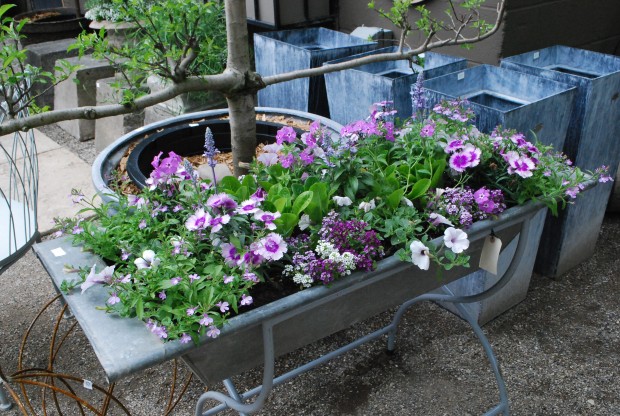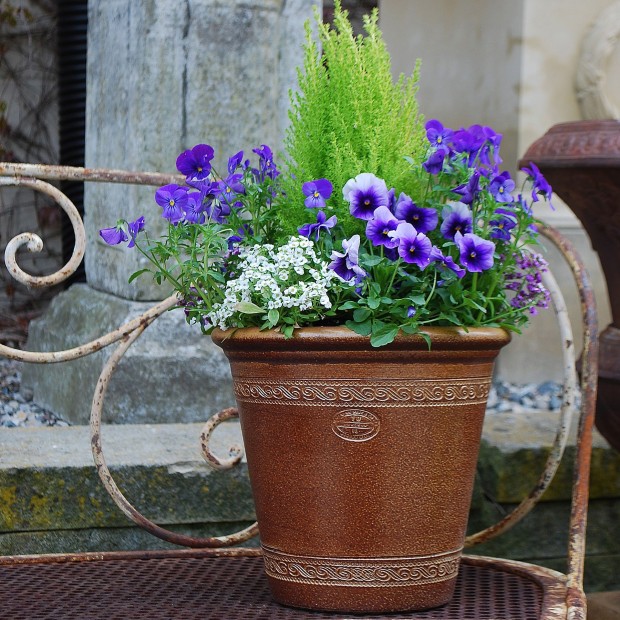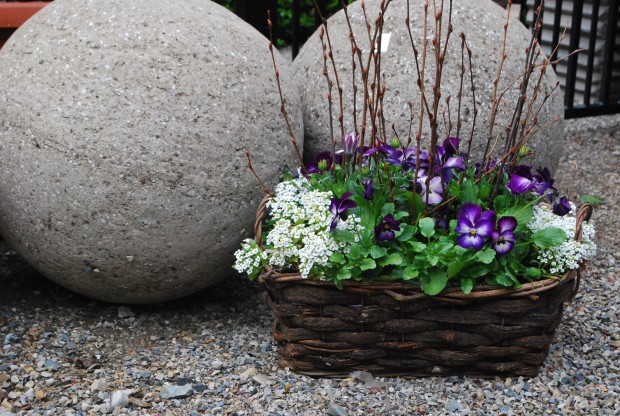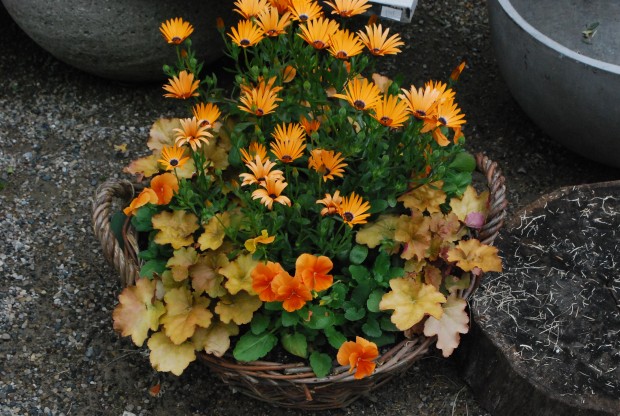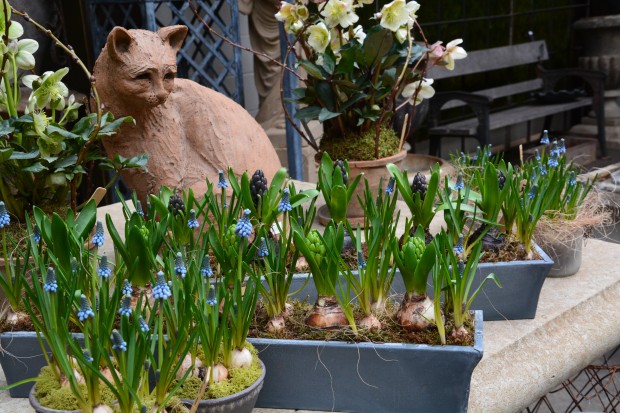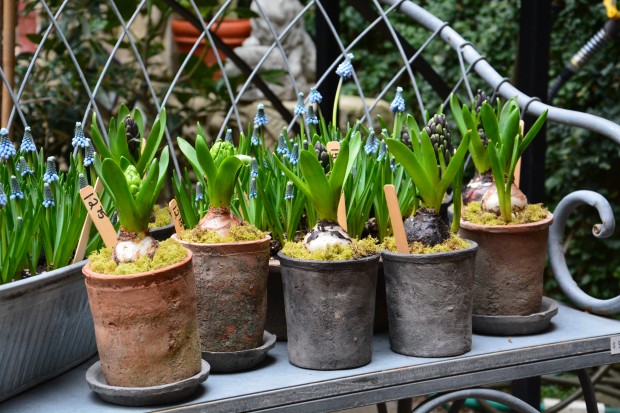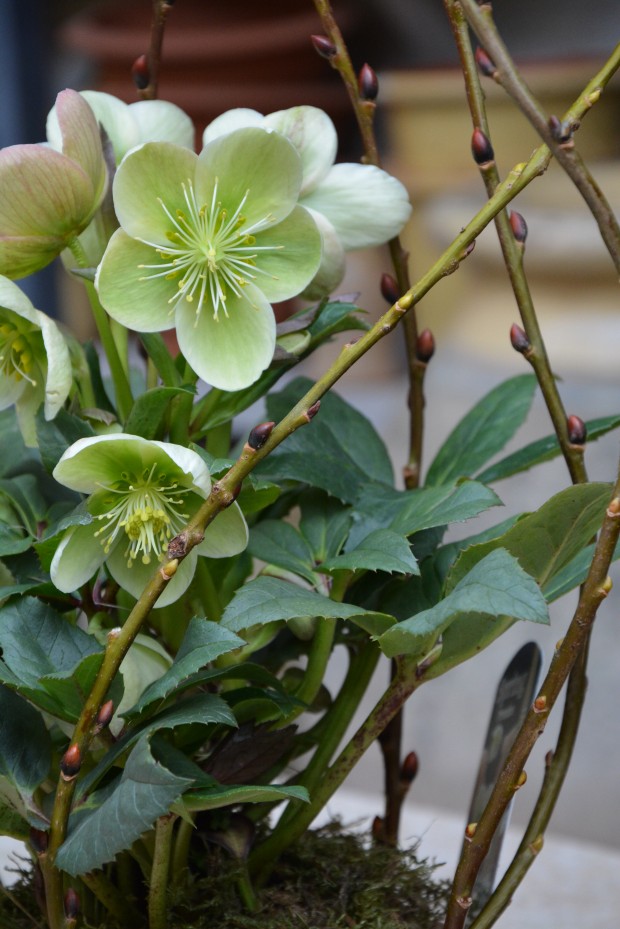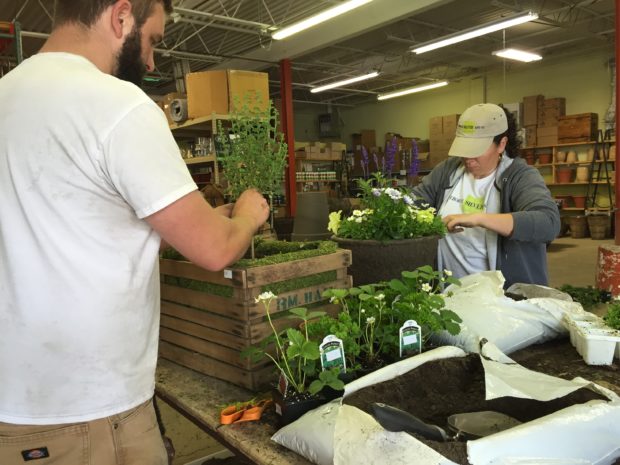 Yesterday morning dawned very windy, very rainy, and very cold. This is entirely normal for Michigan in mid-May. What gardener is surprised by this? All of us. Once Mother’s Day comes and goes, all of us expect that the time to plant summer containers is nigh. Nothing could be further from the reality. Spring in Michigan lasts for 3 months-the same length as any other season. Detroit Garden Works does have plants available now – as in cold tolerant, road ready for a spring container, plants. Cold sensitive summer plants – those are best kept in the greenhouse where they are being grown until the night temperatures are reliably above 50 degrees. . We have planted lots of pots for the shop in the past month, but all of those plants are adaptable to chilly spring conditions.
Yesterday morning dawned very windy, very rainy, and very cold. This is entirely normal for Michigan in mid-May. What gardener is surprised by this? All of us. Once Mother’s Day comes and goes, all of us expect that the time to plant summer containers is nigh. Nothing could be further from the reality. Spring in Michigan lasts for 3 months-the same length as any other season. Detroit Garden Works does have plants available now – as in cold tolerant, road ready for a spring container, plants. Cold sensitive summer plants – those are best kept in the greenhouse where they are being grown until the night temperatures are reliably above 50 degrees. . We have planted lots of pots for the shop in the past month, but all of those plants are adaptable to chilly spring conditions.
 We had lots of people come in yesterday, in spite of the pouring rain and cold. Our Amanda spent half the day scheming with Rob about how to protect our plants from the predicted overnight low of 32 degrees. Gardeners of every persuasion, dressed in fleeces, rain jackets, sweaters, knee high rain boots and warm hats were asking in one way or another about when to plant for summer. I gave the same answer that I always give. not now; not yet.
We had lots of people come in yesterday, in spite of the pouring rain and cold. Our Amanda spent half the day scheming with Rob about how to protect our plants from the predicted overnight low of 32 degrees. Gardeners of every persuasion, dressed in fleeces, rain jackets, sweaters, knee high rain boots and warm hats were asking in one way or another about when to plant for summer. I gave the same answer that I always give. not now; not yet.
 It is fine to plant containers for spring now. It has been fine since late March. A late March planted container will thrive until the beginning of July. March, April and May are spring months in Michigan. Only cold tolerant plants thrive in containers during the spring season. Our summer season opens in June, and goes through August. Would that I could convince more northern zone gardeners to celebrate the spring with lots of spring flowering bulbs and cold tolerant container plants. We hold a spring fair every year, with exactly that purpose in mind. There is so much about the spring season to enjoy. Experiencing the process of the landscape and garden waking up in spring is an extraordinarily beautiful phase.
It is fine to plant containers for spring now. It has been fine since late March. A late March planted container will thrive until the beginning of July. March, April and May are spring months in Michigan. Only cold tolerant plants thrive in containers during the spring season. Our summer season opens in June, and goes through August. Would that I could convince more northern zone gardeners to celebrate the spring with lots of spring flowering bulbs and cold tolerant container plants. We hold a spring fair every year, with exactly that purpose in mind. There is so much about the spring season to enjoy. Experiencing the process of the landscape and garden waking up in spring is an extraordinarily beautiful phase.
 We planted lots of containers with daffodils this past fall. From the moment the leaves broke ground until the blooms began to open was over 6 weeks ago. Watching those bulbs break dormancy is an experience of the spring season that is not to be missed. A container planted with spring flowering bulbs provides a visual short course in how the seasons change from winter to spring. Some foliage that emerged early was damaged during a run of very cold nights in late March. The flower buds were unharmed, as they came later. Our cold persisted throughout April, and now in to May. Those normal chilly temperatures are a luxury. All the spring flowers going into nature’s cooler at night means they are available to enjoy over the longest possible period of time.
We planted lots of containers with daffodils this past fall. From the moment the leaves broke ground until the blooms began to open was over 6 weeks ago. Watching those bulbs break dormancy is an experience of the spring season that is not to be missed. A container planted with spring flowering bulbs provides a visual short course in how the seasons change from winter to spring. Some foliage that emerged early was damaged during a run of very cold nights in late March. The flower buds were unharmed, as they came later. Our cold persisted throughout April, and now in to May. Those normal chilly temperatures are a luxury. All the spring flowers going into nature’s cooler at night means they are available to enjoy over the longest possible period of time.
 You may think the spring arrives overnight, and vanishes within a few days. This is not the case. The trouble and expense of planting containers for spring will be rewarded with a whole season’s worth of pleasure. We do not force our daffodils. We pot them up, and winter them in our unheated garage. As soon as the temperatures warm a bit in March, we move them outside. The fact that the bulbs are not forced into bloom outside of their normal season means they can be planted out in the garden, where they will bloom at the normal time next year.
You may think the spring arrives overnight, and vanishes within a few days. This is not the case. The trouble and expense of planting containers for spring will be rewarded with a whole season’s worth of pleasure. We do not force our daffodils. We pot them up, and winter them in our unheated garage. As soon as the temperatures warm a bit in March, we move them outside. The fact that the bulbs are not forced into bloom outside of their normal season means they can be planted out in the garden, where they will bloom at the normal time next year.
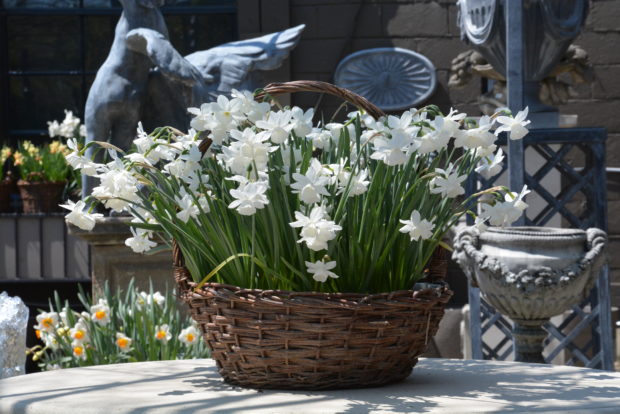 It is not a good idea to plant for summer just yet. There are so many good options for spring one hardly knows where to begin. In the garden, the hellebores and spring flowering bulbs have been in bloom for weeks. The scilla hyacinthoides and camassia are coming on. The sweet woodruff, and loads of spring wildflowers are in bloom. The Virginia bluebells are particularly good this year. The magnolias are still holding on, and the crabapples are still coming on. The American dogwoods are in full bloom. My clematis have been growing steadily, and are budding up. A dense patch of ornithogalum is in bloom. The fern fronds are uncurling, and the hostas spikes roll out new leaves every day. The fresh leaves on the Princeton Gold maples are the most intense shade of chartreuse imaginable. So much spring around us! There is something new to see every day. These are not the dog days of summer. These are the emerging days. Some containers to compliment the spring season-a natural.
It is not a good idea to plant for summer just yet. There are so many good options for spring one hardly knows where to begin. In the garden, the hellebores and spring flowering bulbs have been in bloom for weeks. The scilla hyacinthoides and camassia are coming on. The sweet woodruff, and loads of spring wildflowers are in bloom. The Virginia bluebells are particularly good this year. The magnolias are still holding on, and the crabapples are still coming on. The American dogwoods are in full bloom. My clematis have been growing steadily, and are budding up. A dense patch of ornithogalum is in bloom. The fern fronds are uncurling, and the hostas spikes roll out new leaves every day. The fresh leaves on the Princeton Gold maples are the most intense shade of chartreuse imaginable. So much spring around us! There is something new to see every day. These are not the dog days of summer. These are the emerging days. Some containers to compliment the spring season-a natural.
 Is it fine to plant containers for summer right now? No, it is not. Spring is not the time to plant for summer. Summer annuals look out of place now, as they are not yet in season. Nor will they do well. Tropical plants set out into cold soil and air temperatures may be set back for for a long time from cold shock. Your local greenhouse can easily reach 80 degrees on better on a sunny day. Plants that thrive at 80 degrees do not want to be outside now. If you made no plans to plant a few containers for spring, it is not too late. What you plant today will be great looking into July.
Is it fine to plant containers for summer right now? No, it is not. Spring is not the time to plant for summer. Summer annuals look out of place now, as they are not yet in season. Nor will they do well. Tropical plants set out into cold soil and air temperatures may be set back for for a long time from cold shock. Your local greenhouse can easily reach 80 degrees on better on a sunny day. Plants that thrive at 80 degrees do not want to be outside now. If you made no plans to plant a few containers for spring, it is not too late. What you plant today will be great looking into July.
 The spring is a great season for container planting.
The spring is a great season for container planting.
